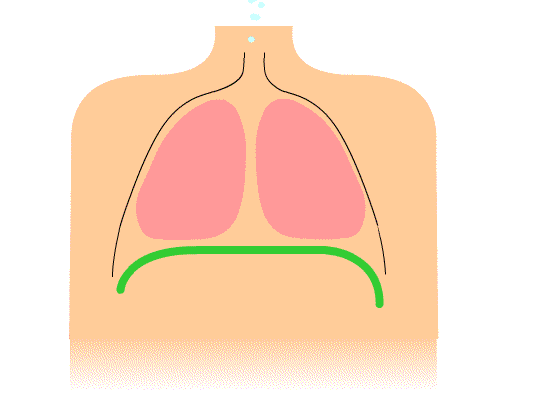Question
What are inefficient versus efficient breathing patterns?
Answer
This Ask the Expert is an edited excerpt from the course, Living Life to its Fullest: One Breath at a Time.
Common Breath Holding Patterns
- Chest Breathing
- Reverse Breathing/Paradoxical Breathing
- Collapsed Breathing
- Hyperventilation
- Dyspnea
I want to review a couple of the common holding or inefficient breathing patterns that we see with our clients. The first one is chest breathing. It is represented in Figure 1.

Figure 1. Illustration of chest breathing.
It shows primarily how the shoulders go up and down with inspiration, and the diaphragm is not moving much. Many clients of mine breathe this way. If I tell them to take a deep breath, their shoulders will go up, their chest expands, but there is not much movement lower down. The secondary muscles of respiration, the scalenes (SCM) are doing a lot more work than they should, and the diaphragm, the primary muscle, is barely contributing. The diaphragm is not being utilized to full capacity. This creates a more rapid and shallow breath.
Reverse breathing or paradoxical breathing is in about 10% of the people that I work with. If you put your hand on your belly and you breathe in, you should feel the belly bulge out a little bit. When you exhale, the belly should go in. Ten percent do the reverse. When they breathe in, the belly pulls towards the spine, and when breathing out, it goes in the opposite direction. This can be changed as it is not a healthy pattern of breathing. What we are going to discuss today will help these people. Clients that perform paradoxical breathing just need a little more time to get that pattern turned around.
Collapsed breathing has a lot to do with posture. This is where the person is hunched over and collapsed in the front. This poor posture influences their breathing.
Many people can demonstrate a mild version of hyperventilation with their respiratory rates in the low 20s.
All of these combined lead to dyspnea or shortness of breath.
Impact of These Breathing Patterns
- Chronic tension in the upper body, especially around the neck, shoulders, back, and jaw
- Anxiety and increased stress response (heart disease, hypertension)
- Lack of circulation in the abdominal area leading to indigestion, heartburn, and bloating
- Greater difficulty learning movement because the basic pattern of breathing (movement) can be upside down
- Confused and disoriented state of mind
The impact of these poor breathing patterns can be chronic tension in the upper neck muscles and scalenes as they are overworking. People often have chronic pain in their neck pain, shoulders, or jaw. The rapid respiratory rate leads to an increased stress response which has a direct relationship to heart disease, hypertension, and many other issues. The stress response also ties directly to the lack of circulation in the abdominal area, which can contribute to indigestion, heartburn, and bloating. If a person is in a fight or flight mode because their respiratory rate is quick, the blood that would be normally in their belly is going to be shunted to their arms, legs, and brain in preparation for flight. So, even when there is no threat, rapid breathing can kick off a sympathetic response that will influence digestion.
Efficient Breathing
- More energy to engage in occupations
- A calmer, clearer perspective
- Manage pain
- Greater ease of movement
When we breathe inefficiently, movement becomes a challenge. For example, if I am trying to help a client learn how to weight shift, but they are breathing inefficiently, they may not be able to coordinate their breath with the task. And, if they have a mild version of hyperventilation, this can lead to confusion or a slightly disoriented state.

Figure 2. More efficient breathing pattern with diaphragmatic movement.
This picture is showing a more efficient breathing pattern. You can see the diaphragm moving up and down. On inhale, it goes down, and on exhale, it goes up. We also do not see the shoulders moving in this illustration, but they should move a little bit.
During belly breathing as the diaphragm goes down, it compresses the abdominal organs. If the abdominals are relaxed enough, the belly will pop out. We often refer to this as diaphragmatic breathing or belly breathing. Air obviously does not go into the belly.
The diaphragm, which is a big powerful muscle, pushes down on those abdominal organs and the belly. As I said, the abdominals will expand if they are not bound or too tight. Figure 3 shows two triangles superimposed on the body of a gentleman.

Figure 3. The upright triangle represents efficient breathing and the upside triangle represents inefficient breathing.
When we breathe more efficiently, the base of the triangle (on the left) is larger representing where there is more movement related to breathing. We should feel more movement in the stomach area and less movement up towards the neck/shoulders (apex of the triangle). For many people, the triangle is upside down with more movement up top and less movement down below (right picture).
As we help our clients to breathe more efficiently, what are the benefits? They have the energy to engage in occupations. They also have a calmer or clearer perspective because they are engaging the parasympathetic branch of the autonomic nervous system. It can help to manage pain. Some of you may have attended the pain symposium on OccupationalTherapy.com. I am repeating a little of that talk to reiterate that breath is a wonderful way to help manage pain. And, as we start to breathe more efficiently, the movement gets easier. This is the goal.
